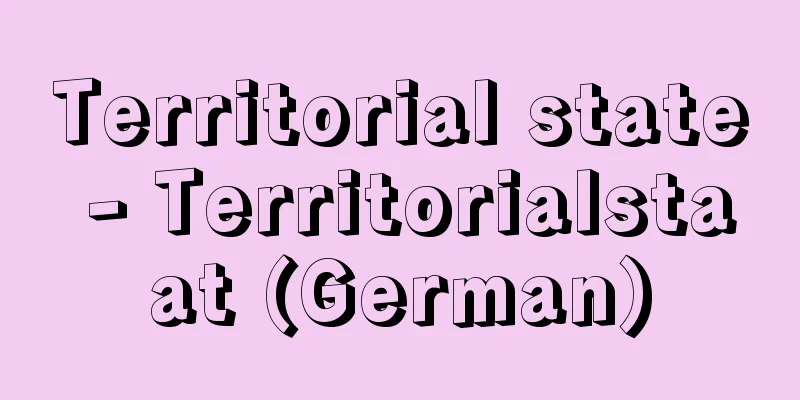Territorial state - Territorialstaat (German)

|
A regional state that constituted the Kingdom of Germany, or Holy Roman Empire, from the late Middle Ages until its dissolution (1806). It is also simply called Territorium (German). The Treaty of Westphalia (1648), which ended the Thirty Years' War, determined the constitution of the Holy Roman Empire (hereafter referred to as the Empire) in the early modern period, and according to it the Empire was made up of over 300 territorial states (this number fluctuated over time) and numerous imperial cities, and each member was recognized to have independent rights equivalent to the sovereignty of a modern state, including diplomatic rights. After that, the Empire became nothing more than a confederation of many sovereign states, but this system was, so to speak, the perfected form of a territorial state, and was formed through a long historical process. [Shosuke Hirajo] The development of territorial sovereigntyOriginally, the medieval German state started as a composite of several tribes and had a tendency to separate feudal states (this tendency is called German particularism), but the powerful royal powers of the Saxon dynasty and the early Salier dynasty suppressed this tendency by various means. This tendency came to the surface during the Investiture Controversy, during which powerful secular and religious lords tried to form a unified domain of rule (terra, later a domain). The term dominus terrae (later a territorial prince) began to be used in this period, but it was not until Frederick II issued two Princely Laws, namely the "Concordat with the Holy Land Princes" (1220) and the "Agreement for the Benefit of the Secular Princes" (1231/32), that the power they had built up through their own power was officially recognized. Frederick II, who was devoted to managing Italy, especially Sicily, made significant concessions in the Princely Laws in order to resolve disputes between him and his son Henry VII (King of Germany), who was in charge of governing Germany within the country, and the princes, granting the princes (dominus terrae) various rights that were originally part of ligalia (royal privileges), such as the right to collect customs duties, the right to mint coins, the right to build castles, and supreme court power (functioning as a higher court than the judicial powers held by the lords within their own territories). This laid the foundations for monarchy that would later develop into feudal sovereignty (Landeshoheit), which was further strengthened during the fall of the Hohenstaufen dynasty and the subsequent Great Interregnum (1256-73). Rudolf I of the Habsburg dynasty sought to recover the lost ligalia, but the political situation in which royal power was transferred from one powerful family to another through elections by the princes (the so-called period of leapfrog elections) prevented this policy from being carried out. Rudolf I also granted powerful princes a "privilege of non-appeal" (the privilege prohibiting them from appealing to the royal court even if they were dissatisfied with the judicial power of the princes), which also completed the judicial supremacy of the princes. The issuance of the Golden Bull by Charles IV (1348), which established a system for electing the emperor by seven electors, also reaffirmed the significant privileges held by the electors and other powerful secular and religious princes, paving the way for the establishment of territorial sovereignty. Later, during the Reformation, the Peace of Augsburg (1555) recognized the principle that "the faith of the ruler governs his territory," and in the territorial states of Protestant princes, the monarchs also gained control over the churches within their territories (the establishment of a territorial church system), paving the way for the territorial state system that was completed with the Treaty of Westphalia. [Shosuke Hirajo] The Reality of the Territorial StateThe number of feudal states varied over time, and their sizes also varied. With the exception of several great secular principalities, such as Brandenburg-Prussia under the Hohenzollerns, Austria under the Habsburgs, and Bavaria under the Wittelsbachs, as well as a few great Holy See principalities, such as the three archbishoprics of Cologne, Mainz, and Trier, and the Archbishopric of Würzburg, most of the states were merely small patrimonial states that did not deserve to be called nations, either in terms of the size of their territory or in terms of their governing structures. In general, European states in the early modern period had a tribal (i.e. estate) system of government, and the situation was the same in the great German feudal states, where the states were divided into the direct domains of the monarch (kammer) and the domains of the vassals. Although the clans and the territorial lords were originally bound together by a feudal relationship of master and servant, when the state was established as a tribal state, the horizontal ties between the clans strengthened, and they came together in a feudal assembly (estate assembly) and showed a clear tendency to oppose the lord. The main issue in the dispute was taxation, and the principle was formed that the monarch could not impose new taxes without the approval of the feudal assembly. Other important political matters such as the succession of the monarch's position, marriage, war, diplomatic issues, and the amendment or abolition of laws also required deliberation by the feudal assembly. In the late modern period, in some large states such as Prussia and Austria, the efforts to hollow out the clans' rights, especially their control over the people within their territories, and to spread bureaucratic governing organizations throughout the entire territory of the state were successful, and the absolutist rule of the feudal lords was established. In particular, Prussia under the rule of Frederick the Great is considered to be a typical example of an enlightened absolutist state. [Shosuke Hirajo] [References] | | | |Source: Shogakukan Encyclopedia Nipponica About Encyclopedia Nipponica Information | Legend |
|
中世後期から神聖ローマ帝国の解体(1806)まで、ドイツ王国=神聖ローマ帝国を構成した地方国家。単に領邦Territorium(ドイツ語)ともよばれる。三十年戦争を終結させたウェストファリア条約(1648)は、近世における神聖ローマ帝国(以下帝国と記す)の国制を決定したものであるが、それによれば帝国は300余り(この数は時代によって変動がある)の領邦国家と多数の帝国都市とによって構成され、各構成員は、外交権を含めてほぼ近代的国家主権に匹敵する自立的な権利をもつことが承認された。以後、帝国は多数の主権国家の連合体にすぎなくなったわけであるが、このような体制はいわば領邦国家の完成形態で、長い歴史的過程を経て形成されたものである。 [平城照介] 領邦主権の発展もともと中世のドイツ国家は、いくつかの部族の合成体として出発したものであり、領邦国家の分立への傾向(この傾向がドイツ分邦主義(パルテイキュラリスムス)とよばれる)をもっていたが、ザクセン朝、初期ザリエル朝の強力な王権は、種々の手段によりこの傾向を押さえてきた。それが表面化したのは聖職叙任権闘争で、この内乱期に聖俗の有力領主は、一円的な支配領域(terra、後の領邦)の形成に努めた。領国領主(dominus terrae、後の領邦君主)ということばはこの時代から用いられ始めるが、彼らが実力でつくりあげた権力が公的に承認されるに至ったのは、フリードリヒ2世の発布した二つの諸侯法、すなわち「聖界諸侯との協約」(1220)と「世俗諸侯の利益のための取決め」(1231/32)においてである。シチリアを中心にイタリア経営に専心していたフリードリヒ2世は、ドイツ国内の統治をゆだねていた息子ハインリヒ7世(ドイツ国王)と諸侯間の紛争を解決するため、両諸侯法で大幅な譲歩を行い、諸侯dominus terraeに関税徴収権、貨幣鋳造権、築城権、裁判高権(諸侯領内の領主たちのもつ裁判権に対する上級審としての機能)等、本来リガリア(国王の特権)に属する諸権利を認めた。これにより将来、領邦主権Landeshoheitに発展する君主権の基礎が置かれ、ホーエンシュタウフェン朝の滅亡とそれに続く大空位時代(1256~73)に領邦君主権はいっそう強化され、ハプスブルク家のルドルフ1世は、失われたリガリアの回収に努めたが、諸侯の選挙により王権が有力家門の間を転々と移動するという政情(いわゆる跳躍選挙時代)が、その政策の貫徹を妨げ、ルドルフ1世が有力諸侯に「不上訴特権」(諸侯の裁判権に不服でも、国王裁判所への上訴を禁止する特権)を与えたことも、諸侯の裁判高権を完成させる結果となった。7人の選帝侯による皇帝選挙の制度を定めたカール4世の金印勅書発布(1348)も、他方では選帝侯をはじめ聖俗の有力諸侯のもつ大幅な特権を再確認し、領邦主権確立への道を開いた。その後宗教改革時代には、アウクスブルクの和議(1555)により「支配者の信仰が領内を支配する」との原則が認められ、新教派諸侯の領邦では、君主は領内の教会に対する統制権をも獲得して(領邦教会制の成立)、ウェストファリア条約で完成する領邦国家体制への道を邁進(まいしん)することになる。 [平城照介] 領邦国家の実体領邦国家の数には時代によって変動があり、その大きさもまちまちであった。ホーエンツォレルン家のブランデンブルク=プロイセン、ハプスブルク家のオーストリア、ウィッテルスバッハ家のバイエルン等をはじめいくつかの世俗大諸侯領、ケルン、マインツ、トリールの三大司教領やウュルツブルク司教領のような若干の聖界大諸侯領を除けば、大部分の領邦は、領土の大きさからいっても、統治機構の面からみても、国家という名に値しない、家産的な小国家にすぎなかった。一般に近世前期のヨーロッパ諸国家は等族制(=身分制)的国制をとっていたが、ドイツの大領邦国家においても事情は同じであり、領邦の内部は君主の直轄領(カンマー)と等族の所領に分かれていた。等族と領邦君主とはもともと封建的主従関係で結ばれていたが、等族制国家の段階になると、等族相互間の横の結合が強まり、領邦議会(身分制議会)に結集して、君主と対抗する傾向が顕著になった。そこで争われた中心的争点は、課税をめぐる問題であり、君主は領邦議会の承認なしに新しく課税することはできないという原則が形成された。そのほか君主の地位の相続や結婚等、さらに戦争や外交問題、法の改廃等の政治上の重要事項も、領邦議会の審議が必要とされた。近世後期になると、プロイセンやオーストリアなどのいくつかの大領邦で、等族の諸権利、とくに所領内の領民に対する支配権を空洞化し、官僚制的統治組織を領邦の全領土に浸透させようとする努力が成功して、領邦君主の絶対主義的支配が確立する。とくにフリードリヒ大王治下のプロイセンは、啓蒙(けいもう)的絶対主義国家の典型とされる。 [平城照介] [参照項目] | | | |出典 小学館 日本大百科全書(ニッポニカ)日本大百科全書(ニッポニカ)について 情報 | 凡例 |
>>: Territorial church - Landeskirche [Germany]
Recommend
Knocking - Nokking (English spelling)
A phenomenon in which abnormal combustion in the ...
Mixteco (English spelling)
A Mexican Indian group. They live mainly in the st...
Ichihashi Nagakatsu
1557-1620 Oda-Toyotomi - A military commander and...
LWR - Eldabourre
《 light water reactor 》⇒ light water reactor LWR [...
Nagatsuka Tomb
This keyhole-shaped tumulus is located in Gongenma...
Shimazu Shigehide
Year of death: Tempo 4.1.15 (1833.3.6) Year of bir...
Inaniwa Udon - Inaniwa Udon
A regional brand of Akita Prefecture, Tohoku regio...
Castelli, B.
…Born in Faenza, he studied mathematics and philo...
Kania, S.
...The independent trade union Solidarity (NSZZ &...
Feuerbach, Ludwig Andreas
Born: July 28, 1804, Landshut Died: September 13, ...
Antandroi tribe - Antandroi tribe
…The Sihanaka people live around Lake Alaotra, an...
Field Ordinance - Denryo
(1) One of the sections of the Code. In the "...
Lindbergh - Charles Augustus Lindbergh
American aviator. Born in Detroit. His father was...
Arusia Accords - Arusia Accords
…The agreement came into force on June 1, 1964, w...
Hwarang - Hwarang
A beautiful young boy worshipped by a group of yo...









